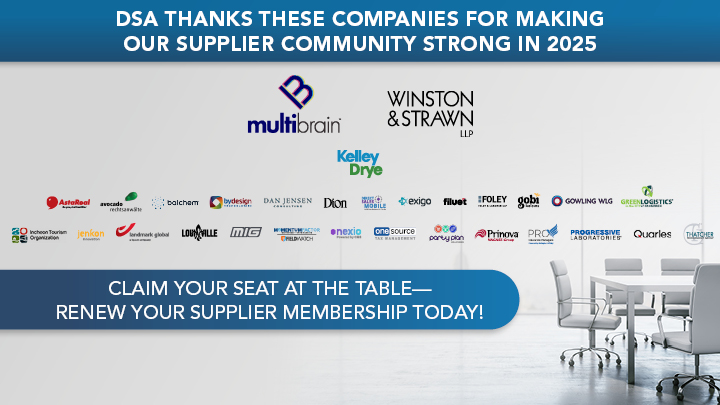

Spring 2025
DSA SupplierSource Summer 2019
What’s Driving the Surge in Supplement Sales—and How Can Your Brand Keep Up?
3 Insights for Direct Selling Executives Navigating the Booming Wellness Market
The U.S. nutrition market is on a fast track for growth, with a projected compound annual growth rate (CAGR) of 5.7% through 2030. Fueled by consumer demand for immunity support, performance enhancement, and healthy aging, dietary supplements are no longer a niche—they’re becoming a daily habit for millions.
But in a crowded market full of bold claims and lookalike products, one factor increasingly separates the brands that succeed from those that fade: scientific credibility.
For direct selling executives leading health and wellness companies, the question becomes clear: How can you stand out while earning consumer trust in a skeptical, science-savvy market?
Here are three strategies:
1. Lead with Ingredient Integrity
Modern consumers want to know what’s in their supplements—and why it works. Products that feature clinically studied ingredients, patented technologies, or transparent sourcing resonate more deeply with informed buyers. Highlighting how a formulation supports bone health, cognition, or cellular function builds confidence and drives repeat purchase behavior.
2. Build Trust Through Transparency
Today’s supplement shoppers are skeptical of vague health claims. Brands that invest in third-party testing, clearly labeled ingredients, and evidence-backed claims have a competitive advantage. Consider how to weave these quality signals into your product training and distributor messaging.
3. Connect Product Benefits to Lifestyle Outcomes
Rather than leading with science alone, tie product attributes to the active lifestyles your customers aspire to. Whether that means joint support for daily movement or nutrients that promote focus and vitality, wellness products perform best when they’re linked to real-world benefits.
Bottom Line:
In a booming market, credibility is currency. Direct selling companies that embrace science-backed formulations, transparent practices, and lifestyle-aligned messaging will be best positioned to capture—and keep—the wellness consumer’s trust.
What Do the Most Resilient Direct Selling Companies Have in Common?
3 Timeless Lessons from 25 Years of Industry Evolution
In an industry shaped by constant change—from new technologies to shifting distributor expectations—why do some direct selling companies not only survive but thrive over decades?
After 25 years of working alongside global direct selling brands, we’ve observed a clear pattern: long-term success isn’t just about innovation. It’s about doubling down on the right fundamentals and using modern tools to scale them.
Here are three enduring lessons that today’s most resilient companies still prioritize:
1. People Stay for the Community, Not Just the Products
Distributors may join for a great product line, but they stay because they feel seen, supported, and part of something meaningful. Systems that foster recognition, mentorship, and peer connection build the emotional glue that drives long-term retention.
2. The Best Tech Enhances the Human Experience
Whether it’s compensation systems, dashboards, or mobile tools, technology works best when it reinforces—not replaces—the personal connections that make direct selling unique. Solutions that feel intuitive and field-ready help leaders lead and sellers sell.
3. Real-Time Visibility Powers Smarter Decisions
Access to timely, actionable insights gives both corporate and field teams the confidence to adjust strategy fast. From promotion performance to distributor activity trends, data becomes a tool for empowerment—not just oversight.
Looking Ahead
As ByDesign Technologies celebrates its 25th anniversary, our most valuable takeaway is simple: companies that stay true to their people—and evolve with purpose—are built to last. The future will bring new tools and trends, but human-centered strategy will always be a competitive edge.

Why Are Teams Disengaging—Even When Business Seems Stable?
What Every Direct Selling Executive Needs to Know About the Hidden Link Between Managers and Performance
Recent data from Gallup’s State of the Global Workplace 2025 report reveals a surprising trend: global employee engagement dropped from 23% to 21% in 2024—only the second time engagement has fallen in over a decade. That decline cost the world economy an estimated $438 billion in lost productivity.
What’s behind the slide? Not economic uncertainty or generational shifts—but manager disengagement.
Managers, especially in the post-pandemic era, are under increased pressure. They’re navigating new executive expectations, evolving field dynamics, and rising emotional demands from teams. When they become overwhelmed or under-supported, engagement drops—and that disengagement cascades down through the organization.
For direct selling companies that rely on high-touch, people-first leadership to energize field performance, this signals an urgent need to invest in manager development. Here’s how:
1. Strengthen the Basics First
Too often, managers are promoted for past performance but never trained for their new role. Providing foundational leadership and role-specific training can cut extreme disengagement in half, according to Gallup.
2. Teach Coaching, Not Just Oversight
Distributors thrive under mentors, not just managers. Help your leaders build real coaching skills—listening, feedback, and guidance—that foster trust and long-term growth.
3. Support Their Growth, Too
High performers don’t just need recognition—they need room to grow. Regular development opportunities, peer forums, and leadership tracks can reignite their own motivation.
The Bottom Line:
In any organization—but especially in direct selling—managers are the fulcrum of performance. When they’re engaged, their teams are, too. And when teams are engaged, productivity, retention, and growth follow.
Recognition matters. But so does reinforcement.
Why "One-and-Done" Training Is Putting Your Business at Risk
3 Ways to Make Compliance Education Work for Today’s Direct Selling Teams
In direct selling, the bigger risk may not be non-compliance—it’s assuming your team understands what compliance actually means.
With fast-moving markets and evolving regulations, relying on one-time onboarding or static manuals just isn’t enough. Legal and executive leaders are finding that to truly protect their businesses, they need to treat compliance as a continuous process, not a one-time event.
Here are three practical strategies for integrating compliance education into the day-to-day operations of a modern direct selling organization:
1. Shift from Policies to Practices
Rather than expecting field reps to memorize lengthy manuals, focus on embedding bite-sized, actionable guidance into the moments that matter. This includes how to talk about product benefits, earnings potential, or health-related outcomes in a compliant, brand-aligned way—right when those conversations happen.
2. Track What Matters
Consistent, trackable training allows leaders to see who’s engaging, what’s being retained, and where there are gaps. This data isn’t just useful for legal—it empowers teams to respond proactively, offer targeted support, and demonstrate due diligence in the event of a regulatory review.
3. Make Learning Easy to Access and Hard to Ignore
Microlearning, interactive scenarios, and multilingual content formats improve adoption and retention—especially across global, mobile-first teams. The key is to meet distributors where they are with content that feels relevant, quick, and useful.
The Bottom Line:
Compliance isn’t just a legal checkbox—it’s a cultural advantage. Companies that integrate continuous training into everyday workflows not only reduce regulatory risk but create more confident, empowered distributors. In today’s environment, that’s not optional—it’s essential.
Why Do Some Global Expansions Fail— Even for the Biggest Brands?
5 Lessons for Direct Selling Executives Planning Cross-Border Growth
Expanding internationally is one of the fastest ways to grow a business—but also one of the easiest ways to lose momentum if not done right. While the potential for increased revenue and brand reach is enticing, global expansion comes with a unique set of risks that even the world’s most established brands haven’t always overcome.
So what separates successful cross-border moves from costly missteps?
Here are five critical lessons direct selling executives should consider when entering new markets:
1. Localization Isn't Optional—It's Foundational
From adapting marketing messages to aligning product positioning with local values, cultural alignment is key. Strategies that succeed in one region may fall flat—or worse, backfire—in another.
2. Pricing Must Account for Currency Volatility
Currency fluctuations can erode margins and distort pricing structures. Build flexibility into your financial modeling and plan for how local payment systems will affect purchasing behavior and trust.
3. Last-Mile Logistics Can Make or Break Customer Experience
Underdeveloped delivery infrastructure and region-specific fulfillment challenges often delay timelines and frustrate customers. Reliable logistics partnerships are essential for consistency and satisfaction.
4. Regulatory Compliance is Never One-Size-Fits-All
Data privacy, labeling, returns, and advertising laws vary widely. A lack of local legal insight can lead to fines, product holds, or blocked entries—slowing momentum significantly.
5. Your Brand May Be Unknown—Or Misunderstood
Global name recognition doesn't always translate locally. A case in point: Sephora’s first store in Hong Kong struggled with brand alignment and cultural missteps, leading to a temporary market exit. A second entry years later succeeded only with greater cultural sensitivity and refined positioning.
Bottom Line:
Cross-border success demands more than a global mindset—it requires deep local insight, operational agility, and cultural fluency. Before planting your flag in a new market, make sure you're doing more than expanding—make sure you're connecting.
Why Do Some Global Expansions Fail— Even for the Biggest Brands?
3 Logistics Lessons Every Direct Selling Executive Should Know Before Crossing Borders
Europe offers vast opportunities for direct selling companies, but those opportunities come with logistical and regulatory complexity that can derail even the most promising expansion.
How do you ensure your brand delivers a seamless customer experience across multiple languages, currencies, and borders, while staying compliant with regional regulations?
Here are three key logistics lessons for direct selling executives planning to launch or grow operations in Europe:
1. Logistics Is More Than Shipping—It’s Strategy
Success in Europe starts with understanding the end-to-end fulfillment process. This includes product registration, customs clearance, VAT compliance, and entity formation—well before the first product ships. Without a strategy grounded in regional expertise, you risk delays, fines, and dissatisfied customers.
2. Localization Drives Loyalty
European consumers expect speed, transparency, and localized experiences. That means real-time inventory visibility, localized warehousing, and returns solutions that feel effortless. Logistics partners with multilingual customer support and knowledge of country-specific last-mile delivery expectations are essential for long-term satisfaction.
3. Central Hubs Accelerate Market Reach
Location matters. Partnering with fulfillment centers in logistics-friendly regions—such as the Netherlands—can reduce transit costs and accelerate delivery across the EU. A central hub also simplifies expansion into neighboring countries without duplicating infrastructure.
The Bottom Line:
Entering Europe isn’t just about having demand—it’s about executing with precision. For direct selling companies, success hinges on choosing partners that understand both logistics and the unique needs of a distributed salesforce. The right infrastructure can turn a daunting expansion into a scalable growth engine.

Are you equipping your sales force with tools that generate revenue?
3 Ways to Ensure Your Seller Tools Actually Deliver ROI
In the evolving world of direct selling, the definition of a “seller” has expanded. From traditional representatives to affiliates, influencers, and referral partners, today’s field is more diverse—and digitally savvy—than ever before. But as companies race to equip this expanding sales force with modern tools, many forget to ask a critical question:
Are these tools producing measurable results—or just adding digital noise?
Here are three guiding principles to help ensure your sales tools are driving real business value:
1. Prioritize Conversion Over Vanity Metrics
It’s easy to get distracted by flashy apps or social tools that generate views, likes, and engagement. But time spent doesn’t always equal revenue earned. Sales tools must be evaluated on their ability to convert—whether it’s clicks into orders, content into leads, or events into transactions. If a tool isn’t tied to a sales outcome, it might be time to reassess.
2. Personalize for Different Seller Profiles
Not every seller needs the same features. Affiliates may thrive with simple, mobile-first dashboards, while team leaders might require deeper reporting and performance tracking. The key is offering flexibility—tailoring the experience so each seller sees what matters most to them.
3. Streamline Customer Conversion
Modern tools should make buying frictionless. Features like curated carts, shareable purchase links, livestream shopping with in-event buy buttons, and subscription flexibility all help sellers convert interest into action—and build stronger customer relationships in the process.
The Takeaway:
In today’s hybrid selling environment, tools should be more than trendy—they should be transformational. The most effective sales technologies are those that make life easier, not just louder, for both sellers and their customers.
